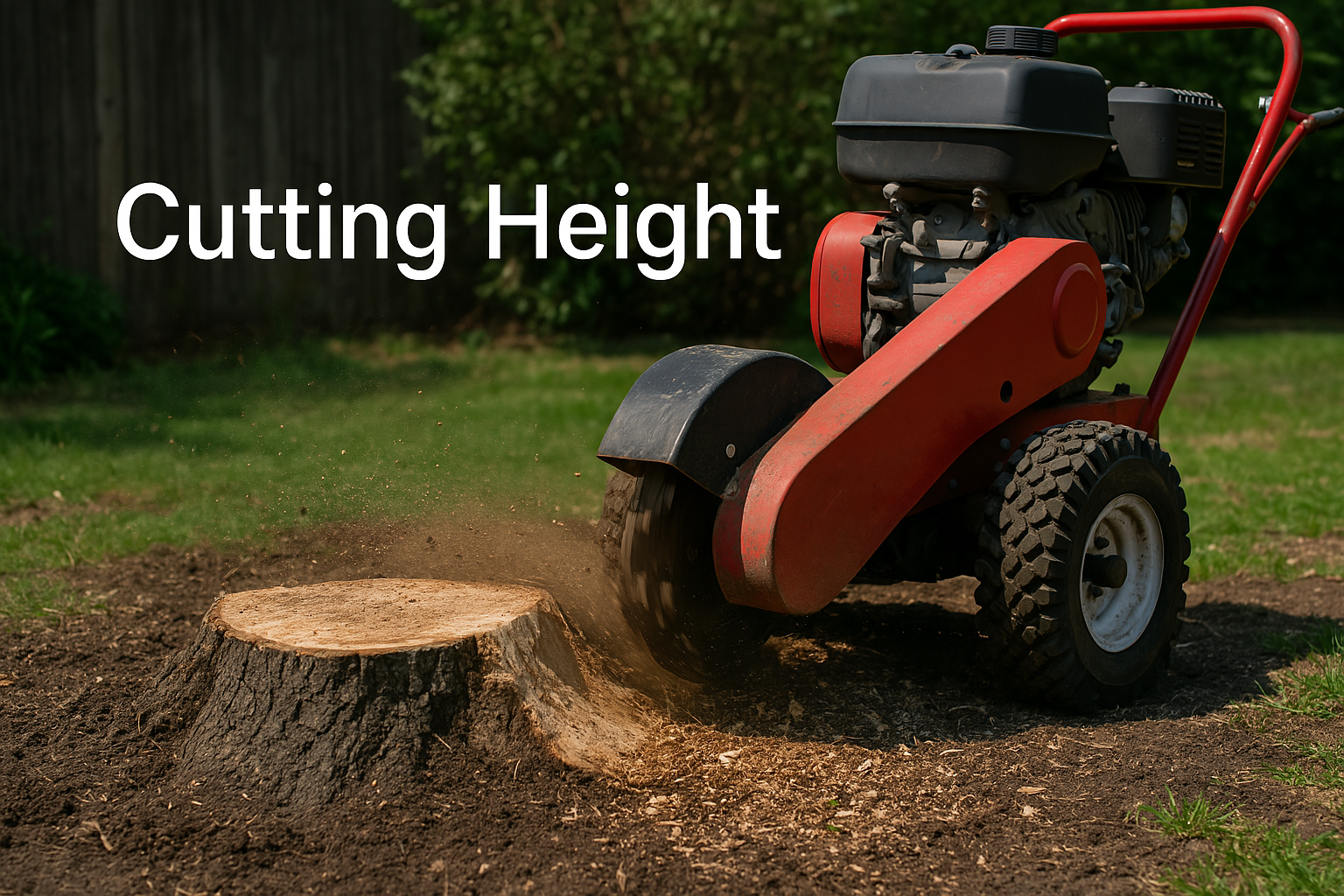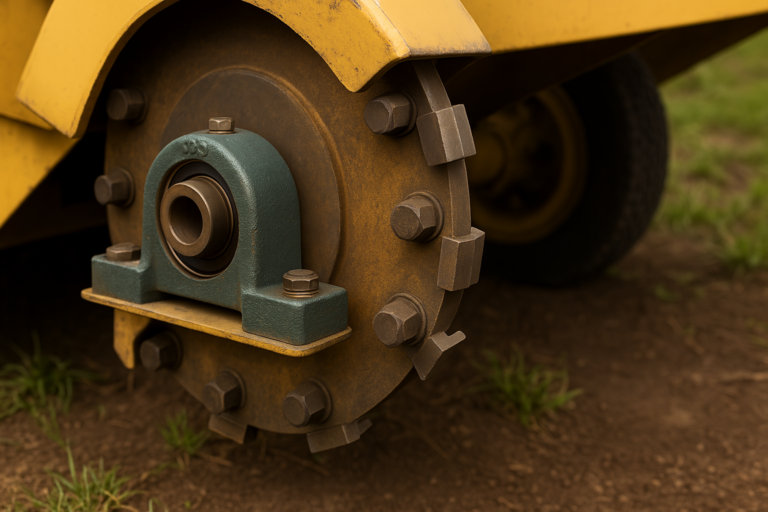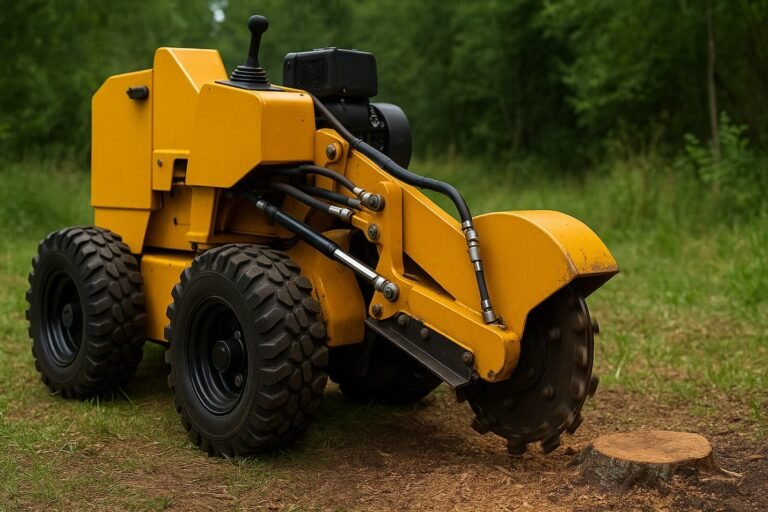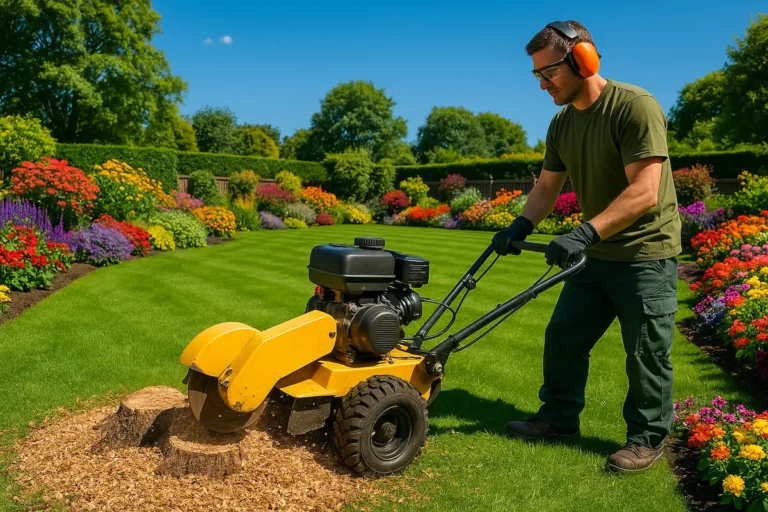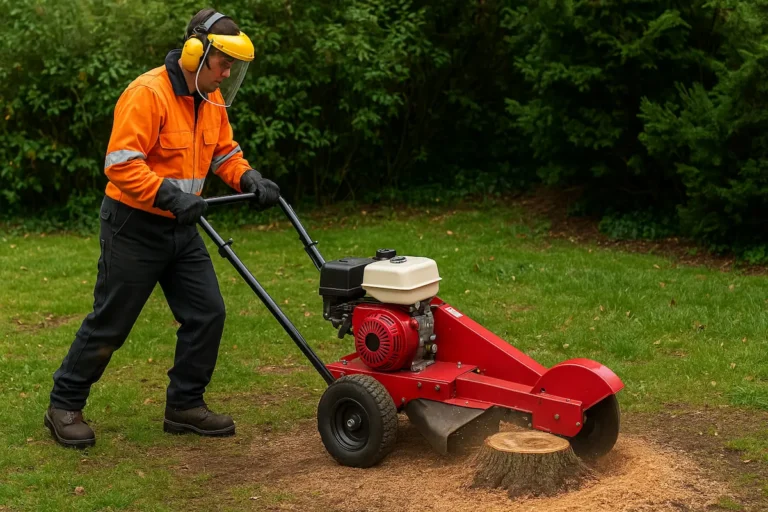Understanding Stump Grinder Cutting Height & Depth: Your UK Hire Guide
Stump grinding uses cutting height.
This means how high above the ground it cuts.
It also means how deep below ground it goes.
Knowing this helps you hire the right machine.
Get your stump removal job done right.
Key Takeaways: Understanding Grinding Depths
- This chart visualizes the recommended below-grade grinding depth ranges (in inches) for common UK landscaping tasks compared to the typical depth range achievable with standard hire stump grinders.
- For basic tasks like laying new turf (6-8 inches) or creating flower beds/planting shrubs (8-12 inches), a typical hire machine (usually 8-14 inches deep) is often sufficient.
- Projects requiring deeper grinding, such as preparing for paving/patios (12+ inches) or especially planting new trees (18+ inches), may exceed the capabilities of smaller hire grinders.
- Always match the machine’s capability to your project’s specific depth requirement. Discuss your needs with the hire company.
- Crucially: Actual achievable depth depends on soil conditions, hidden obstacles, and operator skill. ALWAYS check for underground utilities before grinding.
What Are Cutting Height and Cutting Depth in Stump Grinding?
These terms tell you how much stump the grinder removes.
One is for above the ground.
The other is for below the ground.
Defining Below-Grade Cutting Depth: How Deep Can It Go?
Below-grade cutting depth is super important.
It tells you the deepest the grinder’s wheel can cut underground.
This measurement shows if the machine can remove the stump’s core.
It also shows if it removes the primary roots right below the stump.
This is key for using the land later.
Defining Above-Grade Cutting Height: Tackling Taller Stumps
The above-grade cutting height is different.
It tells you the highest the grinder can cut above the ground.
This matters if your stump is tall.
The grinder needs to cut the tall part down first.
It cuts it down to ground level.
Then, it can start grinding deeper, below the ground.
Why Does Stump Grinding Depth Matter for Your Project?
The depth you need depends on your plans.
What will you do with the area after?
This decides how deep the grinding must go.
Prevent Unsightly Stump Regrowth and Suckers
Grinding deep helps stop the stump from growing back.
Usually, going several inches below ground is needed.
This removes the central growing point of the old tree.
It makes annoying sprouts or suckers less likely later.
Prepare the Ground Correctly for Future Use
The correct depth makes the ground ready for new things.
Different projects need different depths.
We will look at typical examples next.
Recommended Grinding Depths for Common UK Landscaping Tasks
Knowing your project helps you pick the correct depth.
Here are typical depths needed for different jobs.
We list them in inches and millimetres (mm).
Grinding Depth for Laying New Turf (Lawn)
Want to grow new grass where the stump was?
You need enough space for topsoil.
Grassroots also need room to grow.
Aim for 6 to 8 inches deep grinding.
(That’s about 150 to 200 mm).
User Tip:
“I hired a small grinder for my lawn. The hire shop suggested 6 inches deep. It worked perfectly for the new grass seed.”
Grinding Depth for Creating Flower Beds or Planting Shrubs
Planning a flower bed?
Or planting some small bushes?
You should go deeper than for grass.
Aim for around 8 to 12 inches deep.
(That’s about 200 to 300 mm).
This gives new plants more room for their roots.
Grinding Depth Before Laying Paving, Patios, or Driveways
Putting down paving stones?
Building a patio or part of a driveway?
You need space for a solid base layer underneath.
This often means grinding deeper.
Aim for 12 inches (300 mm) or possibly more.
Check how deep your base layer needs to be.
Grinding Depth Required for Planting New Trees
This usually needs the deepest grinding.
You must remove the old stump’s central root mass.
This makes space for the new tree’s root ball.
Aim for 18 inches (450 mm) deep or even more.
Especially if the old tree was enormous.
Expert Advice:
“If you’re replacing a tree, don’t skimp on depth. Grind deep to remove old roots. Give the new tree the best start.”
What Cutting Depth Can You Expect from Hired Stump Grinders?
Stump grinders come in different sizes.
The grinders you can hire yourself are usually smaller.
They have different cutting depths than giant professional machines.
Typical Cutting Depths of Portable & Pedestrian Hire Grinders
These are the grinders you often find at hire shops.
You can walk behind them, or they will be easy to move.
Their below-grade cutting depth is usually:
- 8 to 14 inches (around 200 to 350 mm)
Some smaller electric models might cut less deep.
Key Point: Always check the specific details for the grinder you hire.
Table: Typical Stump Grinder Cutting Depths
| Grinder Type | Typical Below-Grade Depth (Approx.) | Typical Above-Grade Height (Approx.) | Best For |
|---|---|---|---|
| Small / Portable / Hire Machine | 8-14 inches (200-350 mm) | 10-25 inches (250-635 mm) | DIY lawn prep, flower beds, smaller stumps |
| Medium / Commercial | 12-18 inches (300-450 mm) | 20-35 inches (500-890 mm) | Deeper beds, paving prep, professional use |
| Large / Tracked / Professional | 18-25+ inches (450-635 mm+) | 30+ inches (760 mm+) | Replanting trees, very large stumps, tough jobs |
Understanding the Capabilities of Larger Commercial Grinders
Tree surgeons use much bigger grinders.
These powerful machines can go much deeper.
They might reach 18 to 25 inches (450-635 mm) below ground, or even more.
You generally don’t hire these big machines yourself.
They are for demanding, professional jobs.
Factors That Influence the Actual Grinding Depth You Achieve
The machine’s listed maximum depth is just a guide.
You might not always reach that depth.
Several things can affect how deep you grind.
How Machine Power and Size Directly Impact Depth Capability
Bigger grinders have more powerful engines.
More power helps cut deeper, especially in hard ground.
Smaller hire machines have less power.
They might struggle to reach their maximum depth in tough spots.
Dealing with Different Soil Conditions: Clay, Rocks, and Sand
The type of ground makes a big difference.
- Rocky Soil: Very hard to grind deep. Risks damaging the grinder teeth.
- Heavy Clay: Can be rigid and slow going.
- Hidden Junk: Old pipes, concrete, or large stones will stop grinding.
- Sandy Soil: Usually the easiest to grind in.
Real Experience:
“Hired a grinder rated for 12 inches. Hit solid clay and stones about 6 inches down. Couldn’t get any deeper for the shrubs I wanted to plant.”
Operator Skill and Technique: Maximising Your Grind
Using the grinder correctly helps.
An experienced person might get more depth safely.
Take your time and follow instructions carefully.
Sweep the cutting head side to side slowly.
Don’t try to force the machine too deep too quickly.
Common Problems Summary Box
- Hitting Rocks: Stops grinding, can break teeth.
- Heavy Clay: Slows progress, hard work.
- Hidden Debris: Old concrete or pipes are dangerous obstacles.
- Big Roots: Large side roots might limit depth near them.
- Machine Limits: Small hire grinders have depth limits.
- Not Checking Utilities: DANGEROUS! You must check first.
Safety First: You MUST Check for Underground Utilities Before Grinding
This is the most crucial step before you start.
You must know if there are pipes or cables underground.
Why Locating Gas, Water, and Electric Lines is Essential
Hitting hidden pipes or wires is extremely dangerous.
- Gas Pipes: Can cause leaks, fires, or explosions.
- Water Pipes: Can cause flooding and damage.
- Electric Cables: Can cause electrocution, fire, and power cuts.
- Phone/Internet Cables: Can cut off services.
Safety is more important than grinding depth.
How Buried Utilities Restrict Safe Grinding Depth
If pipes or cables are present, you cannot grind near them.
You must stay a safe distance away.
This often means you cannot grind as deep as you want.
Or you might not be able to grind that stump at all.
Always use a utility location service before you dig or grind. In the UK, you can find utility plans by checking resources online.
SAFETY CALLOUT: Never grind without checking for hidden pipes and cables first! Your safety depends on it.
Choosing the Right Stump Grinder Hire for Your Depth Needs
Now you know more about depth.
You can choose the right hire grinder.
Assess Your Project: How Deep Do You Need to Go?
Think carefully about your plans for the area.
- Just growing grass? 6-8 inches might be acceptable.
- Planting a big new tree? You need 18+ inches.
Decide your required depth before you look at machines.
Discuss Your Requirements with the Hire Professionals
Talk to the stump grinder hire company.
Tell them:
- How deep do you need to grind?
- What are your plans (grass, paving, etc.)?
- What is your soil like (if you know it)?
- How big is the stump?
They can recommend the best grinder for your specific job.
They know the capabilities of their machines.
Don’t Forget Above-Grade Height: Dealing with Tall Stumps
We focused a lot on depth below ground.
But the height above ground matters for tall stumps.
Matching Machine Height Capability to Your Stump Size
Check the grinder’s maximum above-grade cutting height.
Make sure it’s high enough to tackle your stump.
If the stump is very tall, you need a reachable machine.
It needs to cut the stump down to ground level first.
Then, you can start grinding below the surface.
Key Takeaways: Getting Stump Grinding Depth Right
Getting the depth right makes your project work.
Here are the main points to remember:
- Know your needed depth: Decide based on your plans (grass, paving, planting).
- Check machine specs: Look at the below-grade cutting depth of hire grinders.
- Regarding site factors, Soil type, rocks, and hidden objects affect real depth.
- Prioritise safety: Always check for underground utilities before starting.
- Hire appropriately: Choose a grinder that matches your depth needs and site conditions. Talk to the hire company for advice.
Conclusion: Plan Your Depth, Grind Safely
Understanding cutting depth is key for stump grinding success.
Plan how deep you need to go for your specific project.
Remember that site conditions and safety rules can limit depth.
Always check for utilities before you start grinding.
Choose the right hire machine for your needs.
Ready to tackle that stump?
Check out our tree stump grinder hire options now! Find the right machine to get your job done effectively and safely.

